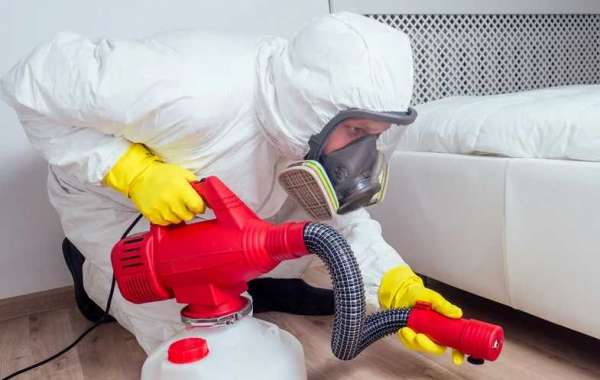Bed bugs, often associated with uncleanliness, are a common yet misunderstood nuisance in many households. Understanding bed bugs is essential in identifying an infestation. These tiny, reddish-brown insects, about the size of an apple seed, are known for their elusive behaviour and nocturnal habits. Early discovery of bed bugs simplifies treatment and elimination.
Misidentifying these pests or delaying action can lead to their rapid spread within a home. Moreover professional bed bug removal will help you to fix the situation. We aim to equip homeowners with the knowledge to identify the top signs of a bed bug infestation, guiding them towards effective solutions for a bug-free living environment.
Top 10 Signs of Bed Bug Infestation
Unexplained Itchy Bites
The most premature symptom of a bed bug infestation is the presence of small, itchy bites, often in a line or cluster. These bites are usually found on exposed arms, legs, and the back. The bites may appear red and swollen, often with a dark spot in the centre. They can be intensely itchy and lead to skin infections if scratched excessively. Bed bug bites are distinct from other insect bites due to their linear or clustered pattern and can appear within a few hours to several days after being bitten.
Blood Stains on Bedding
Tiny blood spots on your sheets or pillowcases are a telltale of bed bugs. These stains occur when bed bugs are accidentally crushed after feeding. The spots might be small and sporadic, resembling tiny ink splatters. They can clearly indicate an active infestation, especially when found consistently over several days. Additionally, these blood spots may sometimes be accompanied by lighter, yellowish stains, which are the excretions of the bed bugs.
Bed Bug Faecal Spots
Dark or rusty areas of bed bug droppings on sheets, mattresses, bedclothes, and walls are common indicators of their presence. These spots are typically smaller than a pinhead and may appear in clusters. The faecal matter results from the bed bugs digesting the blood they have fed on. Over time, these spots can spread to nearby furniture, curtains, and even electrical outlets, indicating a growing infestation.
Distinctive Musty Odour
A heavy, sweet, musty odour, similar to that of berries, can indicate a large bed bug infestation. Bed bugs' scent glands produce this smell. It is often described as a sickly-sweet, rotten raspberry scent and becomes more noticeable with a larger infestation. The odour is a defensive mechanism for bed bugs and can linger on bedding and clothing. In some cases, the smell might be the first indication of an infestation, particularly when visual signs are not immediately apparent.
Bed Bug Egg Shells and Shed Skins
Tiny, pale yellow skins that nymphs shed as they grow larger can often be found near their hiding places. These sheddings signify a growing population, as bed bugs moult several times before reaching maturity. The eggshells, which are tiny and white, may also be found in the same areas. Finding these skins and eggshells indicates an active breeding infestation, not just a few stray bugs. They are typically found in the crevices of mattresses, box springs, and furniture, often escaping the naked eye unless closely inspected.
Live Bed Bugs
Although challenging, the actual sighting of live bed bugs is a definitive sign. Adult bed bugs are reddish-brown, about the size of an apple seed. They are more commonly seen after feeding when their bodies are engorged and redder in colour. Spotting live bed bugs can be difficult due to their fast movement and tendency to hide during the day. They are most likely found by carefully inspecting the seams of mattresses and furniture, especially during the night or early morning hours.
Bed Bug Nests
Look for bed bugs' nesting areas in mattress seams, bed frames, headboards, and furniture near beds. These nests can appear as small black or brown spots or clusters of bed bugs in different life stages. Nests are often located in dark, undisturbed areas close to where people sleep, such as the corners and undersides of mattresses and box springs. Finding a nest indicates a long-term infestation and suggests that the bed bugs have established a significant colony.
Nighttime Biting
Increased biting activity at night, especially when lying in bed, strongly indicates a bed bug infestation. Bed bugs are drawn to the body heat and exhaled carbon dioxide of sleeping people. It can lead to multiple bites over consecutive nights, often worsening as the infestation grows. The bites might also appear in more significant numbers and different body areas as the bed bugs spread across the sleeping surface.
Bed Bug Hiding Spots
Inspecting cracks in walls, electrical outlets, and other small spaces is crucial for detecting bed bugs, as these pests excel at hiding in the most inconspicuous places. In addition to the typical spots like mattress seams and furniture joints, bed bugs can also be found behind picture frames, within folds of curtains, and in the stitchings of chairs and couches. They may even hide in screw holes and between floorboards. These hiding spots are often near sleeping areas, as bed bugs like to be close to their food source.
Reactions in Pets
Pets might exhibit distress or itching due to bed bug bites, though bed bugs prefer human hosts. While not their first choice, bed bugs will bite pets if human hosts are unavailable. Signs in pets include scratching or biting at the skin more than usual, restless behaviour, and visible red spots or rashes on their skin. Bed bugs might also hide in pet bedding and areas where pets frequently sleep or rest. Inspecting pet areas and bedding is important as part of a comprehensive approach to identifying and managing a bed bug infestation in the home.
Preventing Bed Bug Infestations
Prevention is key to avoiding bed bug problems. Early infestation detection may be achieved by regularly inspecting mattress and box spring seams. Any bed bugs or their eggs that may be in carpets, upholstery, or bedding may be removed by vacuuming. To stop bed bugs from entering and hiding in mattresses and pillows, it's also a good idea to cover them with protective coverings.
Exercise caution when bringing used furniture into your house, as it can be home to bed bugs. To prevent taking these pests home with you, before travelling, check hotel rooms for indications of bed bugs and keep baggage off the floor. Reducing clutter in your home can also limit potential hiding spots for bed bugs.
Treating a Bed Bug Infestation
Once a bed bug infestation is identified, prompt action is crucial to prevent its spread. DIY methods include:
- Thorough cleaning and vacuuming of the affected area.
- Use boiling water to wash all clothing and bedding.
- Using a steam cleaner on mattresses and furniture.
Bed bug-specific sprays and powders can also be used, but ensure they are safe for indoor use and follow all instructions carefully. Encasing mattresses and pillows in bed bug-proof covers can trap the bugs inside and prevent further infestation. For severe cases, professional extermination is often the most effective solution.
Pest control professionals can use various techniques, including chemical treatments and heat treatments, to eliminate bed bugs. To guarantee the infestation is fully gone, it may be required to do follow-up inspections and treatments regularly.
Conclusion
Effectively managing a bed bug infestation hinges on early detection and prompt action. Recognizing signs such as itchy bites, blood stains on bedding, and a musty odour is key to early intervention. Regular inspections and preventive measures like vacuuming and using protective covers are crucial. Combining DIY methods with professional extermination offers the best chance of eradicating these pests in case of an infestation. Prompt, vigilant responses are essential in maintaining a bed bug-free home.









